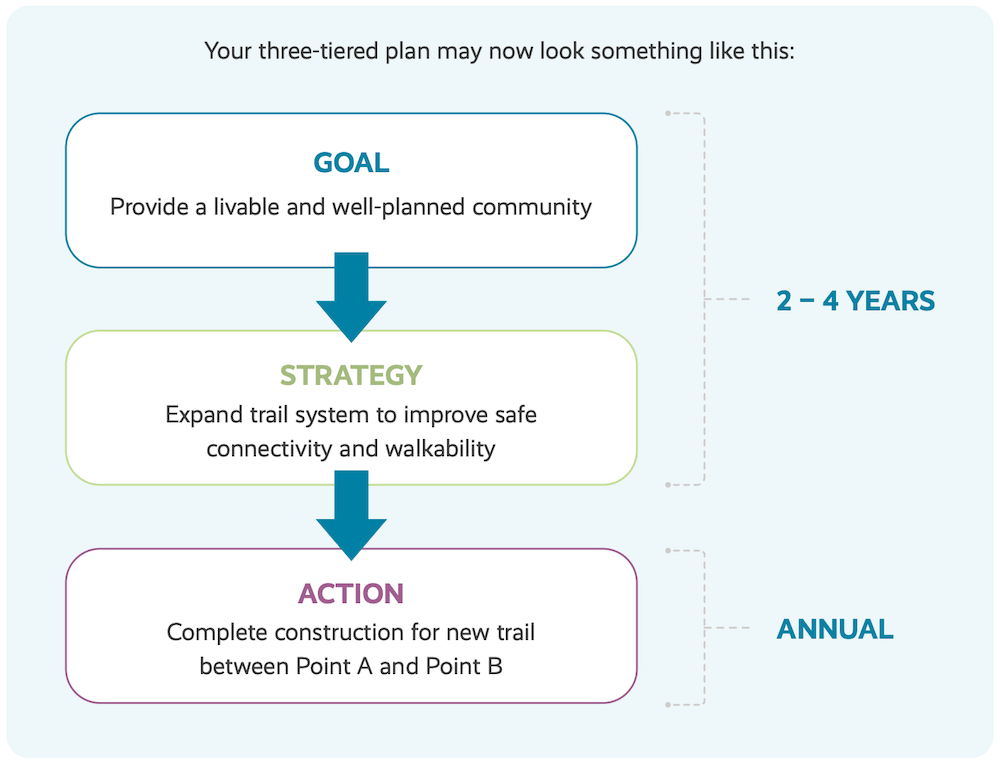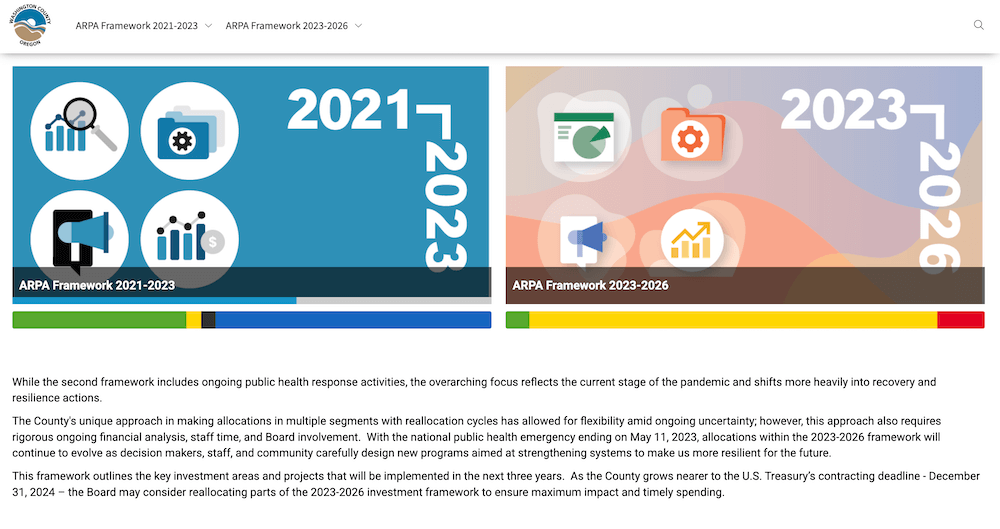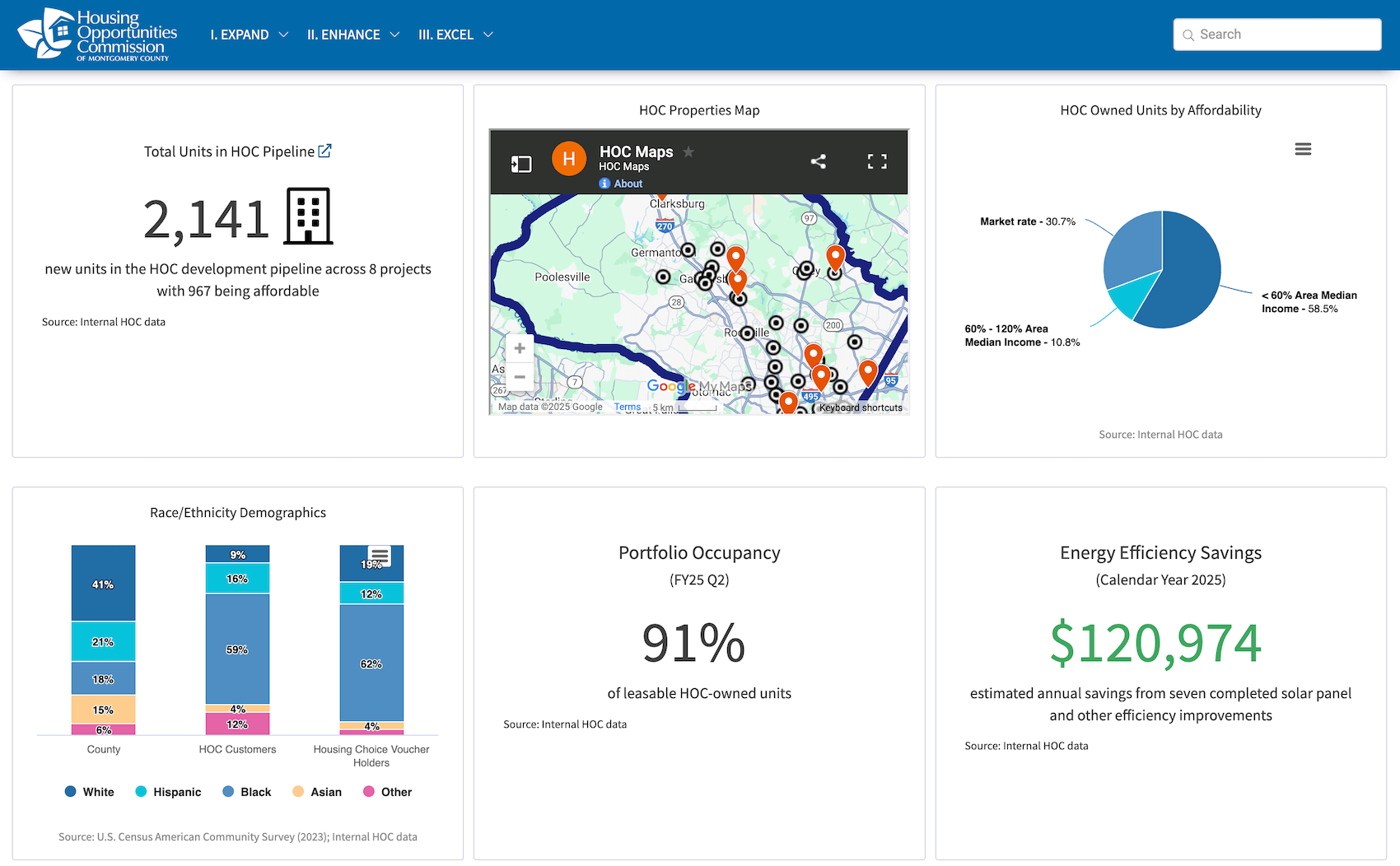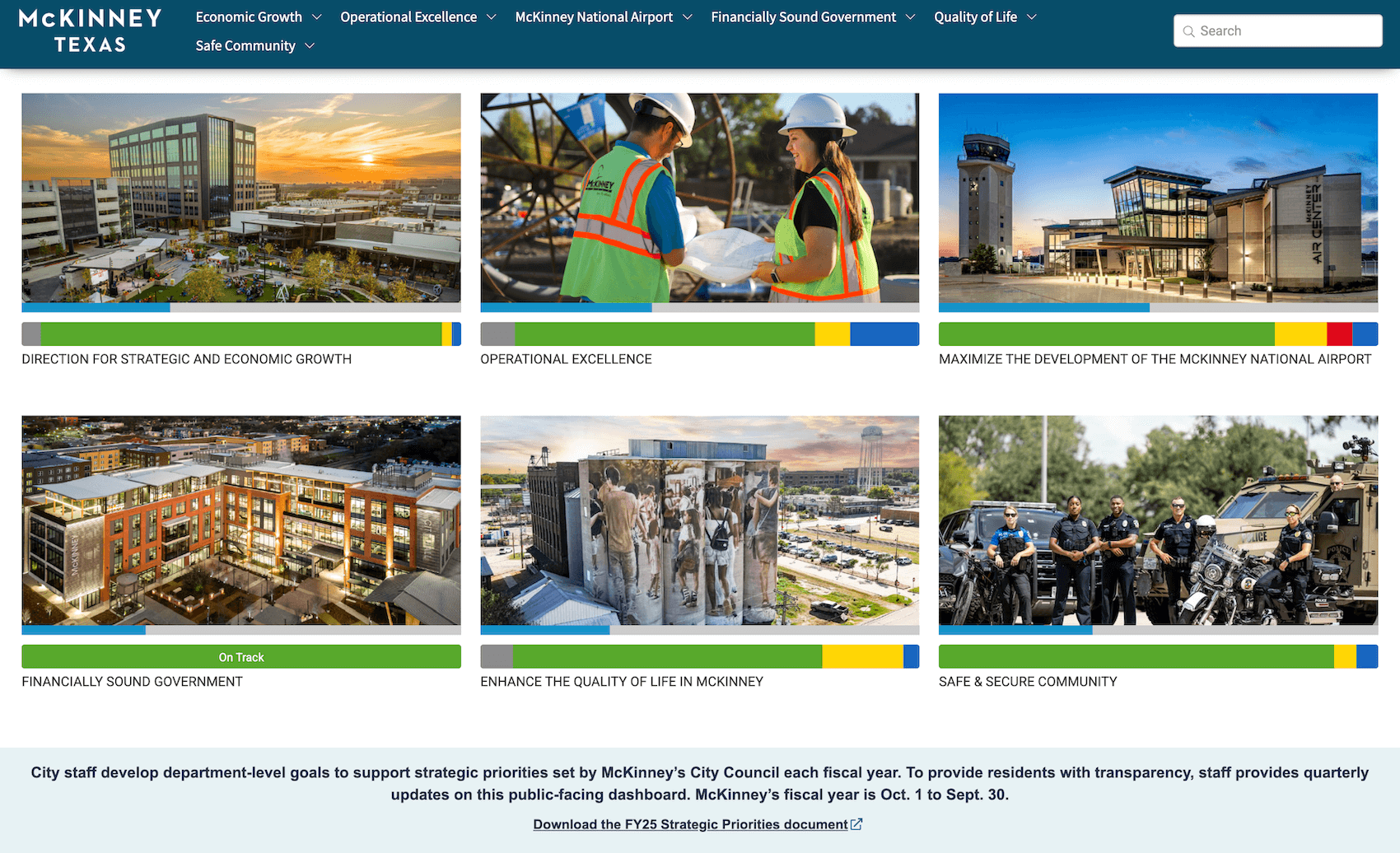Contents
Summary
All strategic planning models rely on the same essentials: clear goals, defined strategies, and consistent implementation. The right model is simply the one your organization can execute well.
Key takeaways:
- All models share three core parts: goals, strategies, implementation
- Fit to leadership style matters more than the model itself
- Clear KPIs strengthen any framework
- SMART actions make strategy actionable
- Regular monitoring keeps plans effective
Local governments and other public sector organizations need strategic plans that perform.
With limited resources, competing priorities, and rising demands for transparency, public sector organizations must develop strategic planning processes that not only look good on paper, but also drive measurable results.
There are many strategic planning models to choose from, and selecting the right framework can be tough. The reality is that the specific strategic planning model you choose matters less than you might think.
That’s because most strategic planning models share the same core elements. The real difference lies in how leaders prefer to frame, discuss, and visualize challenges. Ultimately, the best model is the one that aligns with your organization’s leadership style and culture, because that’s going to be the one that’s easier to implement.
The purpose of developing a strategic planning process is to align organizational resources to achieve long-range goals and measurable outcomes. A well-executed strategic plan can help you deliver on your mission and build trust with your community. A poorly executed one? It collects dust on a shelf.
In this post, we break down:
- The most widely used strategic planning models
- How to structure an effective planning process in terms of goal setting, strategy formulation, and implementation
- Essential tools that will help you out during the execution process
- Real-world examples of success
Let’s dive in.
Strategic planning models: Choosing the right framework
The first step in building a strong strategic plan is selecting a model that fits your organization’s goals, leadership style, and culture. There’s no one-size-fits-all approach—but understanding the strengths of each framework can help you decide what is right for you and your team.
Common strategic planning models in the public sector
Standard Strategic Planning: The most traditional approach—defining long-term (20–50 year) visions, mid-term (2–4 year) goals and strategies, and short-term actions based on community research.
Community-Based Strategic Planning / Visioning: Community-based strategic planning, also known as community visioning, actively involves residents in shaping their community’s future by establishing a shared vision and clear action steps.
Council Goal-Setting: Elected officials define a focused set of priorities to align budgets and actions quickly.
Strategic Gap / Need Analysis: Identifies the gap between current performance and desired outcomes, then outlines a path to close it.
Scenario Planning: Scenario planning is a strategic method we see often in our higher education customers. It involves exploring various plausible futures by generating multiple well-crafted, contradictory narratives, helping institutions prepare for uncertainties and navigate volatile, uncertain, complex, and ambiguous (VUCA) situations.
Issue-Based Planning: Starts with current challenges and builds targeted strategies to address them.
Private-sector strategic planning approaches in government strategy
Some local governments also incorporate private-sector planning models:
Objectives and Key Results (OKRs): This framework sets ambitious goals and measurable key results, ensuring accountability and alignment across departments. For example, a city might set an objective to reduce carbon emissions, with key results tracking reductions in vehicle miles traveled and increased renewable energy adoption.
Hoshin Kanri: This visual strategic planning method, meaning “compass management” in Japanese, helps organizations align long-term goals with daily operations through a structured, seven-step process. Originally developed in post-war Japan, Hoshin Kanri ensures that strategic objectives (typically spanning one to five years) are clearly defined, broken down into annual, monthly, and weekly goals, and communicated throughout all levels of an organization. It typically includes a Plan-Do-Check-Act (PDCA) cycle, that helps track progress and refine strategies over time.
Balanced Scorecard (BSC): This model balances financial and non-financial performance indicators, helping local governments track progress across four key areas: financial stability, community engagement, internal operations, and learning and growth. A municipality might use BSC to monitor resident satisfaction, service delivery efficiency, and workforce development initiatives alongside budget performance.
Self-Organizing Planning: This is a more decentralized approach that empowers teams to collaborate and drive innovation without relying on rigid hierarchical structures. A community-led urban planning project, for example, might engage residents in co-designing public spaces, ensuring that solutions emerge organically from those most affected.
How these 3 strategic planning components work together
Many strategic planning models come with additional tools or activities, but nearly all are built on the same three foundational components:
- Defining success and setting goals
- Formulating strategy
- Strategic plan implementation and reporting
Let’s break down each of these areas to see how they work in practice.
1. Defining success and setting goals
The first step in any strategic planning process is clarifying your long-term vision and defining success. The name doesn’t matter as much as the function. Some organizations call goals strategic priorities, pillars, critical success factors, or focus areas.
The basis of setting goals is understanding what the community and/or organization wants to achieve in a concrete way.
For some communities, these goals will be focused on 5 – 10 years in the future. For others, this means establishing a long-term vision for what it will be like in 20, 30, 50 or even 100 years. A good example of long-term planning can be seen in Indigenous communities and organizations. They often plan well into the future, for example, by using the Seventh Generation Principle, where decisions around resources, sustainability, but also trade agreements and strategic relationships, should be considered for seven generations into the future.
Start with a vision, mission, or core values
Long-Term Vision: What do you want your community or organization to look like in 20, 30, or even 50 years?
Mission Statement: Why does your organization exist?
Core Values (especially in self-organizing models): What principles guide your actions?
It doesn’t matter what you call it—vision, mission, or values—the key is to define a clear, big-picture outcome you want to achieve.
From here, narrow your focus by identifying 3–6 strategic goals or priorities for the next 2–4 years. These should align with your long-term vision and address what the community needs to move forward.
Some organizations call these “strategic priorities”, “focus areas”, “critical success factors,” or “pillars.”
For example, if your long-term vision is to become the safest city in the state, your mid-term goals might include enhancing public safety services, strengthening building codes, and improving emergency communications.
Gather input and analyze current conditions
Strong goal-setting is grounded in data and community engagement. Whatever you decide to call them (goals, pillars, etc.) and however long you want to plan for, at this stage, do an environmental scan to analyze current conditions to make informed decisions. Useful tools include:
- SWOT Analysis (Strengths, Weaknesses, Opportunities, Threats)
- PEST Analysis (Political, Economic, Social, Technological)
- PESTLE Analysis (Including Legal and Environmental factors)
- Service-Demand Analysis (Understand who you’re serving, how, and why).
These tools provide a baseline and help you to identify what must change to move toward your vision.
Identify Key Performance Indicators (KPIs)
Lastly, it is also helpful to identify key performance indicators (KPIs) for each goal that provide quantitative measures of the outcomes you hope to achieve. This allows you to set targets and measure success against objective standards. For each goal, establish KPIs to:
- Set quantitative benchmarks
- Define clear targets
- Measure outcomes objectively
2. Strategy formulation
Once goals are defined and the metrics for success determined, the next step is to define the strategies you’ll use to achieve them. This is the stage of identifying strategies and actions.
This stage is critical in that it takes the big picture thinking behind the vision and goals and injects a bit of reality. What resources will it take to achieve our goals? How long will it take? What do we actually need to do to get to the outcomes we want? What are the things we need to do differently?
In the same way that your goals define the path toward the vision, strategies map the path to the goal. They usually have a shorter time frame, two to four years, and can be framed as objectives for the organization to achieve.
Defining your strategies

Strategies are generally medium-term (2–4 year) approaches that move your organization toward its goals. For example, if we were support the goal of becoming the safest city, the initial strategies we may consider include:
- Reducing property crime
- Minimizing crashes at high-risk intersections
- Improving traffic signal timing
Build SMART actions
Now it’s time to break each strategy into concrete, actionable steps. Each strategy should include SMART actions (Specific, Measurable, Achievable, Realistic or Resourced, and Timebound).
SMART actions help break down broad strategies into concrete steps that drive real progress and make it easier to track performance and outcomes.
For example, if the strategic goal is to reduce traffic accidents, SMART actions could include:
- Conducting traffic studies at high-collision intersections by a certain date to identify root causes.
- Implementing targeted enforcement programs in identified high-risk zones, with a goal of issuing 100 citations per month for key violations like speeding or distracted driving.
- Optimizing traffic signal timing along major corridors by the end of the fiscal year to improve traffic flow and reduce the likelihood of crashes.
For each strategy:
- Define specific actions to be completed in the next 12 months
- Assign each action to a staff member
- Include a clear timeline and performance metrics
These actions should have clear ownership and timelines to ensure accountability and trackable outcomes.
3. Strategic plan implementation and reporting
Now we’re bringing it all together. Once your goals are established and your actions laid out, it’s time to make it happen. Turning vision into action requires thoughtful implementation, consistent monitoring, and transparent reporting, especially for public sector organizations, where accountability and community impact are critical.
A lack of follow-through ultimately creates a lack of trust, which makes implementation much harder in the future.
Everything is harder without trust, from building policy and cross-sector cooperation, to the functioning of democracy itself.
Regardless of the strategic planning model you choose, execution and reporting typically include 4 key elements.
1. Leverage strategy implementation tools
To ensure long-term success, governments and other public sector organizations should use tools like:
- Performance dashboards to track progress: Public reporting and transparency is a great way to inform elected officials and the public.
- Community engagement meetings
- Status monitoring to identify delays or disruptions
- Data-driven adaptability to adjust plans in response to external changes
- Regular reporting for internal leadership and public transparency
Monitor the progress and status of actions
Strategic plans often break long-term goals into short- and mid-term strategies, supported by concrete action items. These actions should be actively tracked to monitor:
- Completion status
- Milestones and timelines
- Assigned ownership
- Progress toward the KPIs you’ve established
Monitoring progress is important to remain agile. Even the most well-thought-out plan will face unexpected challenges. Public sector organizations and local governments face not just leadership changes, but also budget changes, staff turnover, policy shifts, or external events like extreme weather or a public health crisis.
By monitoring plan status in real time, you can:
- Spot delays or off-track initiatives early
- Assess root causes
- Decide whether to extend deadlines, reallocate budget resources, introduce new actions, or pause/discontinue an action
If your pedestrian safety initiative is delayed due to a staffing gap in the traffic engineering team, a timely review can help leadership reallocate resources or adjust the project timeline to avoid a full derailment.
Plans that are regularly monitored and adapted to meet changing needs or respond to evolving internal or external dynamics, are what’s known as “living plans”. Strategic plans should be living in order to most effectively hit your desired goals and community outcomes.
Build in review periods
Most strategic planning models include built-in review periods—often quarterly and annually—especially for multi-year plans. These reviews give government teams a chance to:
- Reassess priorities in response to community needs
- Integrate new data or mandates
- Update timelines or initiatives without losing strategic focus
A rise in traffic-related injuries might prompt a shift in focus from general traffic flow to crosswalk and bike lane improvements. A living, adaptive plan lets you respond quickly—without going back to square one.
Finally, your strategic plan is only useful if folks can understand and engage with it. That means delivering the right information to the right people at the right time.
Establishing a consistent, tailored reporting cadence for different audiences is key. Here is an example reporting framework:

Sharing information and celebrating wins
Transparency builds trust—and celebrating progress builds momentum. Remember to make time and space to:
- Share wins with staff and the public
- Highlight departments or teams achieving key milestones
- Reinforce how short-term actions connect to long-term goals
For example, to keep with our pedestrian safety example, publicizing a 15% drop in speeding-related accidents after implementing traffic calming measures is a great way to show progress, thank the team, and engage the community.
Public dashboards are a great way to do this. Dashboards and reports help you turn all of that great performance data into a compelling story of progress. A public-facing dashboard on public safety initiatives might show real-time metrics on emergency response times, traffic fatalities, and community outreach efforts. This makes strategy feel tangible for residents.
Case studies: Strategic planning processes in action
Washington County, OR – Managing grant funding through ARPA dashboard
Washington County built a public dashboard to show how $117M in ARPA funds are being invested in priorities like broadband, small business support, and public health. The dashboard has clear visual indicators and explanations, making data accessible and actionable for both staff and residents.

The dashboard plays a vital role in:
- Tracking progress on multiple complex initiatives through visual indicators and status monitoring.
- Highlighting measurable outcomes, such as the number of small businesses supported or households connected to broadband, which helps leaders assess whether actions are achieving their intended impact.
- Supporting adaptability, with clearly organized plans for each funding tranche (2021–2023 and 2023–2026), enabling stakeholders to compare, adjust, and realign efforts as needed.
- Fostering public trust, through user-friendly visuals, a transparent breakdown of investments, and accessible language that makes strategic planning feel relevant and tangible to residents.
HOC of Montgomery County – Measuring what matters for affordable housing
HOC uses performance dashboards and KPIs to monitor affordable housing development, energy efficiency, and resident support. With clear visuals, strategic alignment, and transparent reporting, they’ve created a data-informed culture focused on equity and community impact.

HOC’s public-facing dashboards and strategic performance metrics highlight how the organization monitors progress across a broad portfolio of initiatives, from expanding affordable housing to increasing energy efficiency and supporting residents through rental assistance programs.
How HOC excels in performance measurement and reporting:
- Robust progress tracking: HOC tracks everything from unit development and renovation to occupancy rates, voucher allocation, and cost-burdened households—ensuring leadership can make informed, data-backed decisions at every level.
- Strategic alignment with core values: Performance indicators are aligned with HOC’s values of equity, innovation, and partnerships—ensuring data collection supports long-term mission impact, not just compliance.
City of Mckinney, Texas: Effective goal setting creates follow-through
The City of McKinney, Texas, is a model for effective goal-setting and follow-through. Their strategic plan is built around SMART actions, clear accountability, and strong alignment with key priorities such as public safety, economic development, and community engagement.

Here’s just a small snapshot of how they’re bringing their plan to life:
- Community Engagement: They’re hosting resident info sessions, publishing monthly updates, creating educational videos, and launching new neighborhood associations.
- Economic Development: Managing a pipeline of 20+ projects, generating new business leads, and engaging local employers.
- Public Safety: Training residents through emergency preparedness programs and promoting disaster readiness at community events.
- Operational Excellence: Holding strategy meetings, launching awards programs, and tracking digital engagement to strengthen outreach.
McKinney’s approach shows how clear, measurable actions across departments drive meaningful results.
–
Whatever strategic planning model you choose, they all share these three components of goal setting, strategy formulation, and execution. Ultimately, it’s most important to choose a model that feels right for your leadership style and your organizational culture. It’ll be easier to focus on execution, measurement, and adaptability when you do.
↓ Get the guide ↓
Measurement is a key part of strategy. If you’re ready to be a performance measurement pro, check out our guide.





